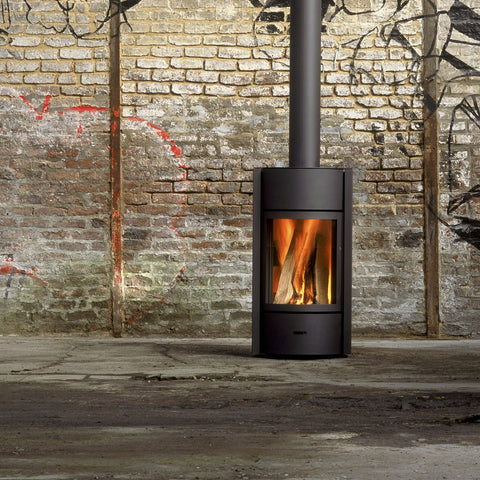
5 Reasons Why Your Wood Fireplace Is Not Burning Properly
Learn why your wood fireplace may not be burning efficiently with this guide to troubleshooting your wood burner's performance.
Wood burning appliances are a popular and efficient way to heat a home, but sometimes you might wonder why your wood burning fireplace is not performing at its best. In this blog post, we will explore the five most common reasons why a wood burning fireplace may not be burning properly. This article will help you troubleshoot many of the most common problems that prevent your wood stove from providing optimal heating for your home.
This guide to troubleshooting why your fireplace is not working covers:
- Improper draught
- Poor wood and poor wood storage
- Air control issues
- Creosote build-up
- Damaged or worn parts

Improper Draught
A good draught is essential for a wood fireplace to work properly. A draught is the flow of air that carries smoke and other by-products of combustion up and out of the chimney. If the draught is not strong enough, smoke can fill the room and the stove will not burn properly. Here are some reasons why a draught may not be working properly:
- Blocked flues or chimneys
- A weak chimney draw
- Inadequate air supply
Blocked flues or chimneys:
Invite a chimney sweep round to inspect your chimney and flue for blockages, such as bird nests or creosote build-up. Any blockages must be cleared before using your stove.
Weak chimney draw:
Make sure you are warming up the flue enough when you start your fire. We recommend the ‘top-down’ method for lighting a fire, which encourages a better burn. If you are struggling to light a fire in a cold fireplace, watch the following useful guide which will provide you helpful tips.
Inadequate air supply:
Make sure your fireplace has an adequate source of fresh air, such as an air vent. Some wood fireplaces like the Stûv wood fireplace range come with an integrated external air connection, feeding them air for combustion directly from outside your property. Also, check the air control settings on your stove to ensure they are not restricting the airflow.
Poor wood and poor wood storage
The type of wood you burn and how you store it can significantly impact your wood burning stove’s performance. If you’re using the wrong type of wood, or if your wood isn’t stored properly, you may experience poor burning performance.
Here are some common mistakes people make when storing wood:
- Storing wood in a damp location
- Storing wood in direct contact with the ground
- Burning green or unseasoned wood
Here are tips for selecting and storing the right type of wood for optimal burning in your wood fireplace.
Storing wood in a damp location:
Store your wood in a dry, well-ventilated location, such as a woodshed or garage. Cover the woodpile with a tarp to protect it from rain and snow.
Storing wood in direct contact with the ground:
Stack your wood on a raised platform or pallet to keep it off the ground. This will prevent moisture from seeping into the wood from the ground.
Burning green or unseasoned wood:
Only burn wood that has been properly seasoned, which means it has been dried to a moisture content of between 14-20%. You can check the moisture content with a meter to ensure it is dry enough. Green or unseasoned wood contains too much moisture, which makes it difficult to burn and produces excessive creosote build-up.
Air Control Issues
Air control is another important factor for efficient log burner performance. If the stove is not getting enough air, it will not burn properly. Likewise, if it’s getting too much air, the stove will burn too hot and waste wood. Here are some common air control issues you may experience with your wood fireplace:
- Clogged air intakes
- Stuck dampers
- Improper use of air controls
Fireplace maintenance is essential. Here are some suggestions for how to avoid air control issues.
Clogged air intakes:
Clean the air intakes on your wood fireplace regularly to prevent blockages. Use a wire brush or a vacuum cleaner to remove any debris or ash.
Stuck dampers:
Lubricate your dampers with a high-temperature lubricant, such as graphite grease. This will prevent them from getting stuck in the open or closed position. Do not use copper grease as this degrades and becomes sticky with temperatures that a stove can achieve.
Improper use of air controls:
Follow the manufacturer’s instructions for using the air controls on your wood burning appliance. In general, you should adjust the air controls to increase or decrease the airflow to the fire as needed.
For a modern glass fronted wood appliance to work efficiently, it requires heat in the flue to create the natural draught. Slumbering an glass fronted wood appliance for long periods can cool the flue down too much, eliminating the needed draught to safely evacuate the flue gases.
Creosote Build-up
Creosote is a sticky, tar-like substance that accumulates in chimneys. It’s a by-product of burning poor quality wood, and when it builds up too much, it can be a fire hazard. Here are some common reasons why creosote may accumulate in your wood fireplace.
- Burning green or unseasoned wood
- Restricting air flow and allowing the stove to slumber
- Not cleaning the stove or chimney regularly
Burning green or unseasoned wood:
Avoid burning green or unseasoned wood, as this produces excessive creosote build-up. Only burn properly seasoned wood.
Restricting air flow:
We do not recommend slumbering the fireplace. Slumbering a wood burning fire, or burning wood at a low temperature over an extended period of time, is not recommended for several reasons. Firstly, slumbering can cause a build-up of soot and tar in the flue. Secondly, burning wood at a low temperature can produce more smoke, which can create more pollutants. It is important to avoid slumbering and instead burn wood at a moderate temperature with plenty of air flow.
Not cleaning the stove or chimney regularly:
Clean your wood stove and chimney regularly to prevent creosote build-up. Cleaning your chimney regularly improves the efficiency of your wood appliance and minimises the risk of fire.
Damaged or Worn Parts
Your wood burning appliance is made up of many parts that work together to provide heat. If any of these parts become damaged or worn, it can affect the stove’s performance. You can purchase spare parts for your wood burning appliance. Here are some common parts that may become worn over time or with frequent use:
- Firebricks
- Gaskets
- Baffles
Wood burning appliances are an excellent way to provide heat to your home. However, to keep your wood fireplace operating at optimal performance, it’s important to troubleshoot common issues, and, where needed, enlist a qualified professional to carry out essential maintenance. By following the tips provided in this blog post, you can ensure that your wood stove provides reliable and efficient heating for your home for many years to come. A well-maintained wood fireplace not only provides warmth and comfort, but it can also help reduce your energy bills, especially if sourcing your own firewood supply.
Where to buy a wood burning fireplace
If you need help with choosing a wood burning appliance, speak to The Fireplace team or one of our agents who can assist with all the elements of planning, surveying your property, and performing the installation itself.

















